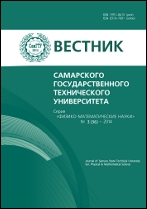|
Mathematical Modeling, Numerical Methods and Software Complexes
Mathematical foundations of epistemology based on experiments
S. M. Krylov
Samara State Technical University, Samara, 443100, Russian Federation
(published under the terms of the Creative Commons Attribution 4.0 International License)
Abstract:
The paper deals with basic prerequisites for the development of epistemology, which uses information concerning real experiments in the real world (with real objects). Such experiments are conducted by “formal-technological” analogs of Turing Machines. These analogs are called “universal synthesizers-analyzers”. They can perform syntheses and analyses of various objects or constructions (obtained by conjunctions of finite number of smaller objects called basic elements) with the help of various algorithmic systems having some restrictions. Such algorithmic systems are called Formal Technologies. They have formal structures that are very similar to the formal structure of Maltsev's algebraic systems. This formal closeness allows us, first, to set up a hypothesis concerning algorithmic basis of almost all surrounding physical processes, as understandable as well as till non-understandable ones, that partially explains the wide applicability of mathematics to the outer world; second, this closeness allows one to formulate and prove some theorems (called assertions) concerning features and peculiar properties of cognitive algorithms in one-, two- or three-dimensional surroundings for various formal technological systems, including a so called “acquired knowledge effectiveness theorem”. The theorem (assertion) can be applied to a very wide class of formal technologies which use an equality predicate for objects analyses. In the paper various cognitive algorithms are listed and proved. These algorithms have different sets of technological operations resembling syntheses and decompositions, as well as different sets of analytical operations including equality predicates, “random stationary mapping” operations (which use unknown algorithms to obtain stationary results, therefore these operations are very similar to oracles in Turing Machines), operations that define object shapes, and so on. The structure of automatic cognitive devices called “cognizers” is described.
Keywords:
cognitive algorithms, physical processes with physical objects, General Formal Technology, General System Theory, object properties, object functionalities, universal object synthesizer-analyzer, universal cognizer.
Original article submitted 20/IV/2015
revision submitted – 30/VI/2015
Citation:
S. M. Krylov, “Mathematical foundations of epistemology based on experiments”, Vestn. Samar. Gos. Tekhn. Univ., Ser. Fiz.-Mat. Nauki [J. Samara State Tech. Univ., Ser. Phys. Math. Sci.], 19:3 (2015), 534–558
Linking options:
https://www.mathnet.ru/eng/vsgtu1427 https://www.mathnet.ru/eng/vsgtu/v219/i3/p534
|

| Statistics & downloads: |
| Abstract page: | 439 | | Full-text PDF : | 270 | | References: | 38 | | First page: | 1 |
|




 Contact us:
Contact us: Terms of Use
Terms of Use
 Registration to the website
Registration to the website Logotypes
Logotypes









 Citation in format
Citation in format 